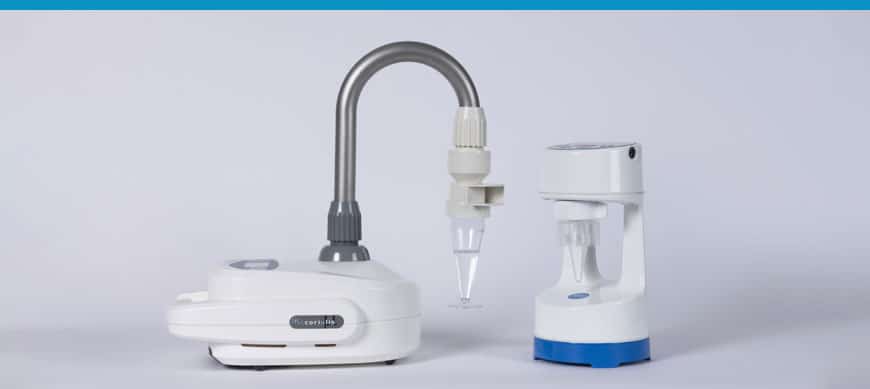Out of the three planetary biospheres: lithosphere (soil), hydrosphere (water), and atmosphere (air), the atmosphere has been, paradoxically, the least investigated for its microbial content. The study of the atmosphere as a microorganism-harboring ecosystem has been technically challenging for years.1
Since 2010, the Coriolis air samplers have been increasingly used in multiple sectors, from academic research to veterinary, healthcare and occupational hazard assessments, among others. For the detection of viruses, bacteria and fungi, from the analysis of Coriolis samples with a wide range of techniques: culture, multiplex PCR, qPCR and RT-ddPCR, metagenomics, microscopy, microfluidic cytometry and LC-MS/MS. Nonetheless, the number of applications for the detection of microorganisms in the air keeps growing, and there is still room for optimization.
Thanks to the more than 300 scientific publications from our users around the world, we are able to identify some of the best sampling strategies and protocols, and improve our technology, as well as our technical support. From their contributions, we have selected three open source research papers that we think could be very useful for the optimization of the collection protocols for the detection of viruses, bacteria and fungi, using our Coriolis biological air samplers. To all of them, a big THANK YOU from Bertin Instruments. Please keep them coming!
- VIRUS DETECTION
Evidence of Air and Surface Contamination with SARS-CoV-2 in a Major Hospital in Portugal
Priscilla Gomes da Silva, José Gonçalves, Ariana Isabel Brito Lopes, Nury Alves Esteves, Gustavo Emanuel Enes Bamba, Maria São José Nascimento, Pedro T. B. S. Branco, Ruben R. G. Soares, Sofia I. V. Sousa and João R. Mesquita
Instrument: Coriolis µ and Coriolis Compact
Collection liquid: sterile phosphate buffered saline (PBS)
Protocol:
- Coriolis Compact: 50 L/min, 60 min
- Coriolis µ: 100 L/min, 10 min – 200 L/min, 10 min and 300 L/min, 10 min
Sample analysis: RNA extraction and RT-qPCR
- BACTERIA DETECTION
Makoto Kokubo, So Fujiyoshi, Daisuke Ogura, Makiko Nakajima, Ayako Fujieda, Jun Noda and Fumito Maruyama
Instrument: Coriolis µ
Collection liquid: phosphate buffered saline (PBS)
Protocol: Coriolis µ: 300 L/min, 10 min
Sample analysis: DNA extraction and sequencing
- FUNGI DETECTION
Antoine Delanoë, Natacha Heutte, Stéphanie Gente, Virginie Séguin and David Garon
Instrument: Coriolis µ
Collection liquid: sterile water containing 0.02% of Tween 80
Protocol: Coriolis µ: 300 L/min, 10 min
Sample analysis: Plate culture
References:
1 Gusareva et al 2019. Microbial communities in the tropical air ecosystem follow a precise diel cycle. PNAS https://doi.org/10.1073/pnas.1908493116
2 Delanoë, Antoine, Natacha Heutte, Stéphanie Gente, Virginie Séguin, et David Garon. 2020. Relationships between Exposure to Bioaerosols, Moldy Surface and Symptoms in French Mold-Damaged Homes. Atmosphere https://doi.org/10.3390/atmos11030223.
3 Kokubo, Makoto, So Fujiyoshi, Daisuke Ogura, Makiko Nakajima, Ayako Fujieda, Jun Noda, et Fumito Maruyama. 2021. Relationship between the Microbiome and Indoor Temperature/Humidity in a Traditional Japanese House with a Thatched Roof in Kyoto, Japan. Diversity https://doi.org/10.3390/d13100475.
4 Silva, Priscilla Gomes da, José Gonçalves, Ariana Isabel Brito Lopes, Nury Alves Esteves, Gustavo Emanuel Enes Bamba, Maria São José Nascimento, Pedro T. B. S. Branco, Ruben R. G. Soares, Sofia I. V. Sousa, et João R. Mesquita. 2022. Evidence of Air and Surface Contamination with SARS-CoV-2 in a Major Hospital in Portugal. International Journal of Environmental Research and Public Health. https://doi.org/10.3390/ijerph19010525.
